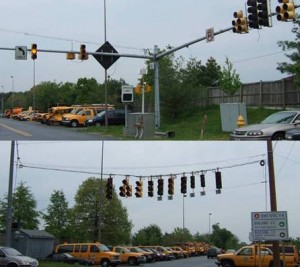 Nationwide, there are increasing concerns about signal poles, due to several reported casualties. New provisions for the traffic structures and their foundation designs are specified in the Year- 2001 published AASHTO “Standard Specifications for Structural Supports for Highway Signs, Luminaires and Traffic Signals.” Provisions should be followed for qualifying signal poles for different loading conditions. This includes span wire type for steel poles and wood poles, mast arm type, back guy wire supports etc..
Nationwide, there are increasing concerns about signal poles, due to several reported casualties. New provisions for the traffic structures and their foundation designs are specified in the Year- 2001 published AASHTO “Standard Specifications for Structural Supports for Highway Signs, Luminaires and Traffic Signals.” Provisions should be followed for qualifying signal poles for different loading conditions. This includes span wire type for steel poles and wood poles, mast arm type, back guy wire supports etc..
The objective of this study is to develop a software program, SPOLE, to evaluate the structural integrity of signal poles. This phase of the project is to develop the SPOLE program to code-check single mast arm, double mast arm, strain steel poles and signal wood poles, back guy wire supports, etc..
The benefits of such an enhanced program relates directly to the safety of the motoring public. A detailed design following the AASHTO Specifications will ensure the integrity of the structure under different loading conditions.
The AASHTO made major changes to “Standard Specifications for Structural Supports for Highway Signs, Luminaires and Traffic Signals” in 2001, and with interims up to 2006. The MDSHA has not implemented the design of the signal poles to meet 2001 AASHTO Specifications yet. The program produced will be called SPOLE which will help The Traffic Engineering Design Division (TEDD) structures team of the Office of Traffic and Safety (OOTS) to check signal poles for the fatigue requirements as per the current AASHTO criteria. This will help in revising the current TEDD structural standards to meet the current AASHTO criteria. The MDSHA is in the process of changing the current sign structure standards using the SABRE software developed by the BEST Center, University of Maryland and the SPOLE will give TEDD a good tool to use and check the existing standards and make revisions to the standards. This is directly related to safety issues as this SPOLE program will be used to check the structural integrity of the signal poles.
Also several times a month the TEDD designers are requested to check the structural integrity of existing poles with new signals and new signs attached to them. The check was performed and a structural recommendation was given within a week as these are computed manually and several code checks have to be performed. Currently, the turn-around time is one week to analyze and check the structural integrity of the signal pole. With the SPOLE program the turn-around time can be cut to one day. There will be cost savings associated with this.
At TEDD, as part of the TERPS (Traffic Engineering Remedial Program for Structures) program, all mast arm signal poles will be inspected in the next inspection cycle which will begin in Fall of 2008. The SPOLE program will be an asset to TEDD for checking the signal poles and making recommendations for remedial action if any structural deficiencies are found during inspection.